Accounting for Business: Financial Statement Analysis Homework
VerifiedAdded on 2022/11/14
|7
|1353
|174
Homework Assignment
AI Summary
This assignment solution addresses key concepts in accounting and finance. Part A focuses on financial ratio analysis, including liquidity and operational performance metrics such as current ratio, quick ratio, accounts receivable turnover, and inventory turnover. The analysis compares the company's performance between 2018 and 2019, highlighting improvements and areas needing attention. Part B delves into the definitions of income and revenue, classifying various transactions like software sales, update downloads, and interest proceeds. It also examines the treatment of discounts and share issuances. Part C applies financial analysis to a lending scenario, comparing two companies, XYZ and ABC, based on liquidity and business risk. The analysis considers how changes in liabilities affect valuation and investment decisions, providing a comprehensive overview of financial statement analysis and its implications for business decision-making.
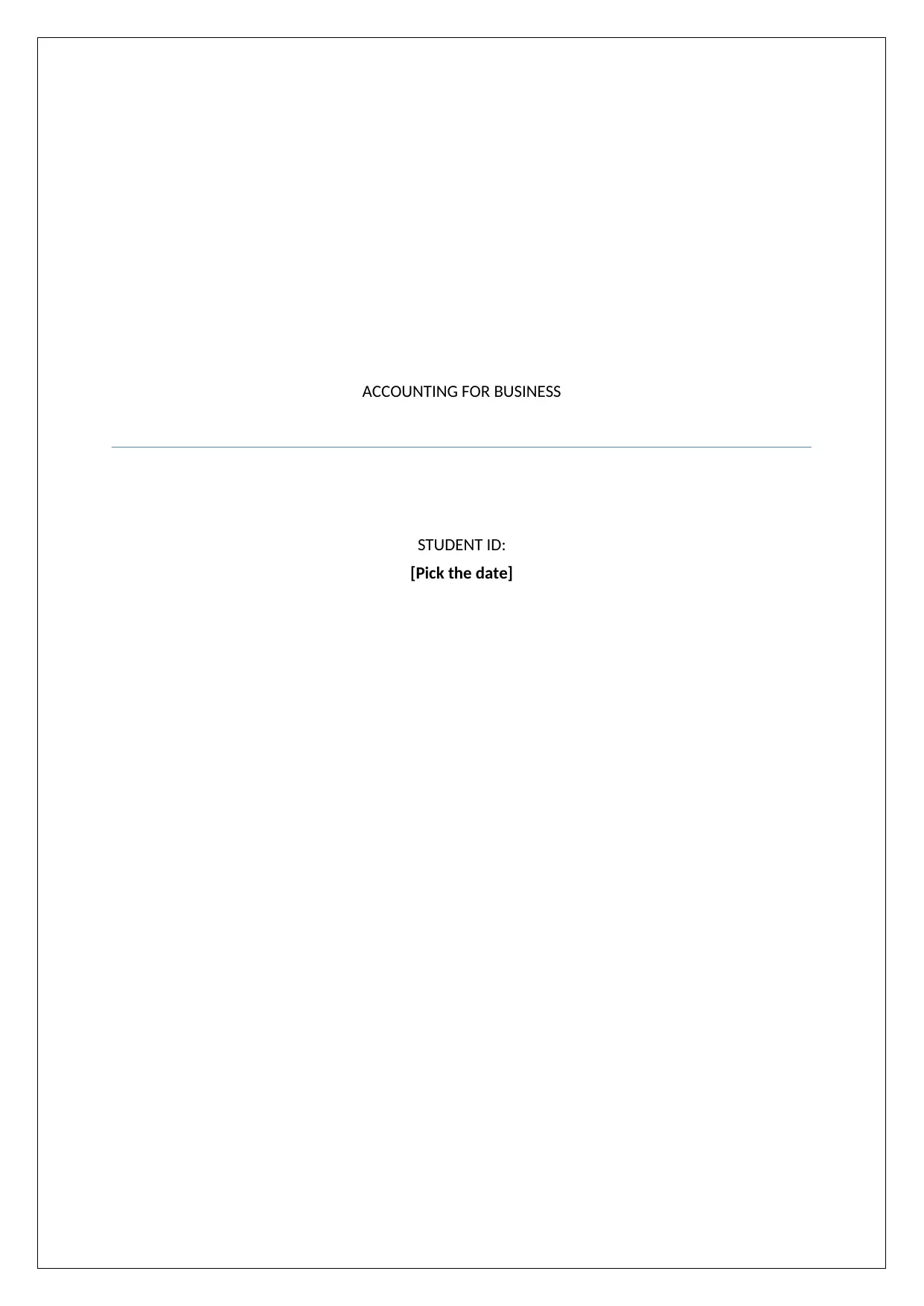
ACCOUNTING FOR BUSINESS
STUDENT ID:
[Pick the date]
STUDENT ID:
[Pick the date]
Paraphrase This Document
Need a fresh take? Get an instant paraphrase of this document with our AI Paraphraser
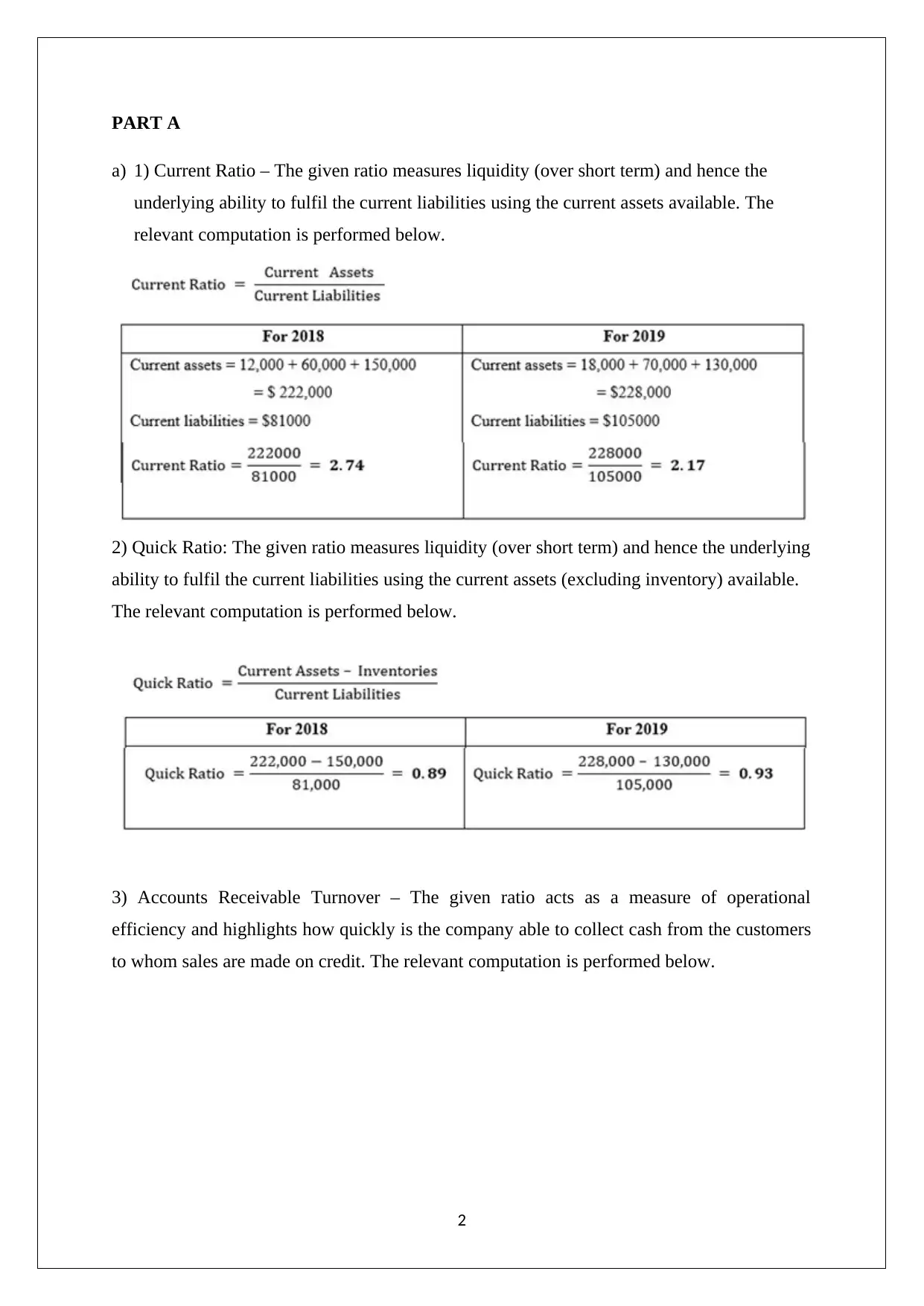
PART A
a) 1) Current Ratio – The given ratio measures liquidity (over short term) and hence the
underlying ability to fulfil the current liabilities using the current assets available. The
relevant computation is performed below.
2) Quick Ratio: The given ratio measures liquidity (over short term) and hence the underlying
ability to fulfil the current liabilities using the current assets (excluding inventory) available.
The relevant computation is performed below.
3) Accounts Receivable Turnover – The given ratio acts as a measure of operational
efficiency and highlights how quickly is the company able to collect cash from the customers
to whom sales are made on credit. The relevant computation is performed below.
2
a) 1) Current Ratio – The given ratio measures liquidity (over short term) and hence the
underlying ability to fulfil the current liabilities using the current assets available. The
relevant computation is performed below.
2) Quick Ratio: The given ratio measures liquidity (over short term) and hence the underlying
ability to fulfil the current liabilities using the current assets (excluding inventory) available.
The relevant computation is performed below.
3) Accounts Receivable Turnover – The given ratio acts as a measure of operational
efficiency and highlights how quickly is the company able to collect cash from the customers
to whom sales are made on credit. The relevant computation is performed below.
2
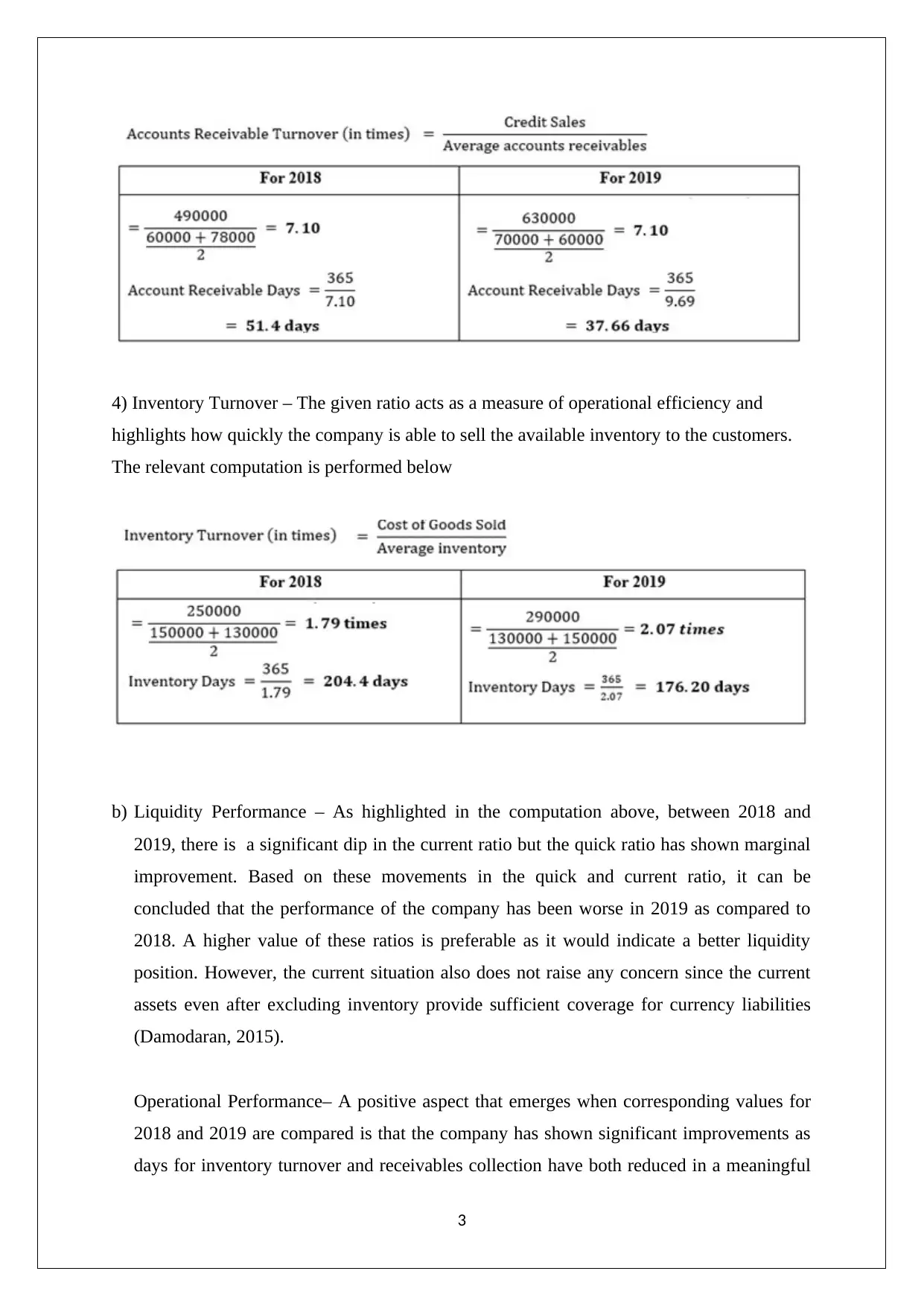
4) Inventory Turnover – The given ratio acts as a measure of operational efficiency and
highlights how quickly the company is able to sell the available inventory to the customers.
The relevant computation is performed below
b) Liquidity Performance – As highlighted in the computation above, between 2018 and
2019, there is a significant dip in the current ratio but the quick ratio has shown marginal
improvement. Based on these movements in the quick and current ratio, it can be
concluded that the performance of the company has been worse in 2019 as compared to
2018. A higher value of these ratios is preferable as it would indicate a better liquidity
position. However, the current situation also does not raise any concern since the current
assets even after excluding inventory provide sufficient coverage for currency liabilities
(Damodaran, 2015).
Operational Performance– A positive aspect that emerges when corresponding values for
2018 and 2019 are compared is that the company has shown significant improvements as
days for inventory turnover and receivables collection have both reduced in a meaningful
3
highlights how quickly the company is able to sell the available inventory to the customers.
The relevant computation is performed below
b) Liquidity Performance – As highlighted in the computation above, between 2018 and
2019, there is a significant dip in the current ratio but the quick ratio has shown marginal
improvement. Based on these movements in the quick and current ratio, it can be
concluded that the performance of the company has been worse in 2019 as compared to
2018. A higher value of these ratios is preferable as it would indicate a better liquidity
position. However, the current situation also does not raise any concern since the current
assets even after excluding inventory provide sufficient coverage for currency liabilities
(Damodaran, 2015).
Operational Performance– A positive aspect that emerges when corresponding values for
2018 and 2019 are compared is that the company has shown significant improvements as
days for inventory turnover and receivables collection have both reduced in a meaningful
3
⊘ This is a preview!⊘
Do you want full access?
Subscribe today to unlock all pages.

Trusted by 1+ million students worldwide
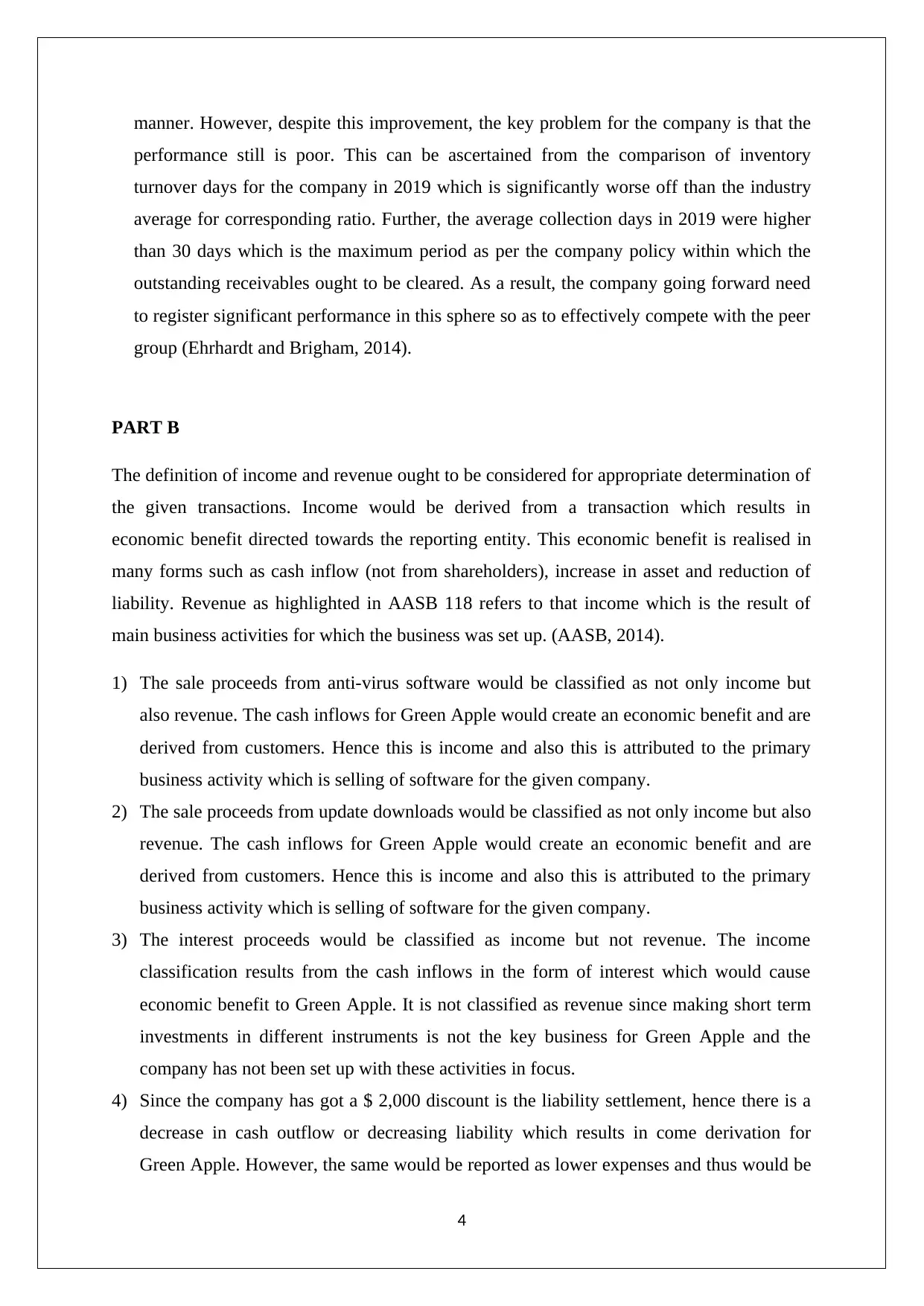
manner. However, despite this improvement, the key problem for the company is that the
performance still is poor. This can be ascertained from the comparison of inventory
turnover days for the company in 2019 which is significantly worse off than the industry
average for corresponding ratio. Further, the average collection days in 2019 were higher
than 30 days which is the maximum period as per the company policy within which the
outstanding receivables ought to be cleared. As a result, the company going forward need
to register significant performance in this sphere so as to effectively compete with the peer
group (Ehrhardt and Brigham, 2014).
PART B
The definition of income and revenue ought to be considered for appropriate determination of
the given transactions. Income would be derived from a transaction which results in
economic benefit directed towards the reporting entity. This economic benefit is realised in
many forms such as cash inflow (not from shareholders), increase in asset and reduction of
liability. Revenue as highlighted in AASB 118 refers to that income which is the result of
main business activities for which the business was set up. (AASB, 2014).
1) The sale proceeds from anti-virus software would be classified as not only income but
also revenue. The cash inflows for Green Apple would create an economic benefit and are
derived from customers. Hence this is income and also this is attributed to the primary
business activity which is selling of software for the given company.
2) The sale proceeds from update downloads would be classified as not only income but also
revenue. The cash inflows for Green Apple would create an economic benefit and are
derived from customers. Hence this is income and also this is attributed to the primary
business activity which is selling of software for the given company.
3) The interest proceeds would be classified as income but not revenue. The income
classification results from the cash inflows in the form of interest which would cause
economic benefit to Green Apple. It is not classified as revenue since making short term
investments in different instruments is not the key business for Green Apple and the
company has not been set up with these activities in focus.
4) Since the company has got a $ 2,000 discount is the liability settlement, hence there is a
decrease in cash outflow or decreasing liability which results in come derivation for
Green Apple. However, the same would be reported as lower expenses and thus would be
4
performance still is poor. This can be ascertained from the comparison of inventory
turnover days for the company in 2019 which is significantly worse off than the industry
average for corresponding ratio. Further, the average collection days in 2019 were higher
than 30 days which is the maximum period as per the company policy within which the
outstanding receivables ought to be cleared. As a result, the company going forward need
to register significant performance in this sphere so as to effectively compete with the peer
group (Ehrhardt and Brigham, 2014).
PART B
The definition of income and revenue ought to be considered for appropriate determination of
the given transactions. Income would be derived from a transaction which results in
economic benefit directed towards the reporting entity. This economic benefit is realised in
many forms such as cash inflow (not from shareholders), increase in asset and reduction of
liability. Revenue as highlighted in AASB 118 refers to that income which is the result of
main business activities for which the business was set up. (AASB, 2014).
1) The sale proceeds from anti-virus software would be classified as not only income but
also revenue. The cash inflows for Green Apple would create an economic benefit and are
derived from customers. Hence this is income and also this is attributed to the primary
business activity which is selling of software for the given company.
2) The sale proceeds from update downloads would be classified as not only income but also
revenue. The cash inflows for Green Apple would create an economic benefit and are
derived from customers. Hence this is income and also this is attributed to the primary
business activity which is selling of software for the given company.
3) The interest proceeds would be classified as income but not revenue. The income
classification results from the cash inflows in the form of interest which would cause
economic benefit to Green Apple. It is not classified as revenue since making short term
investments in different instruments is not the key business for Green Apple and the
company has not been set up with these activities in focus.
4) Since the company has got a $ 2,000 discount is the liability settlement, hence there is a
decrease in cash outflow or decreasing liability which results in come derivation for
Green Apple. However, the same would be reported as lower expenses and thus would be
4
Paraphrase This Document
Need a fresh take? Get an instant paraphrase of this document with our AI Paraphraser
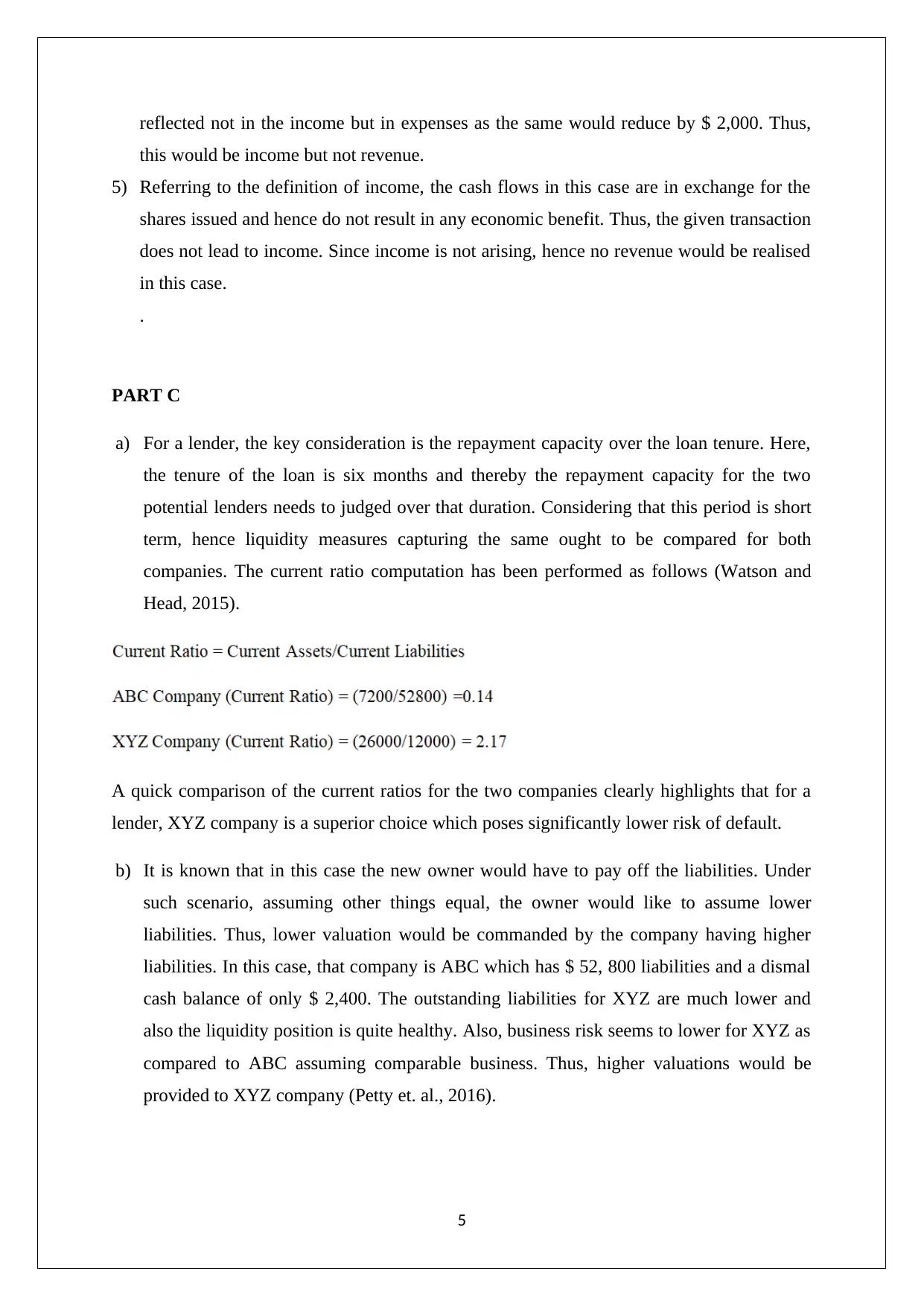
reflected not in the income but in expenses as the same would reduce by $ 2,000. Thus,
this would be income but not revenue.
5) Referring to the definition of income, the cash flows in this case are in exchange for the
shares issued and hence do not result in any economic benefit. Thus, the given transaction
does not lead to income. Since income is not arising, hence no revenue would be realised
in this case.
.
PART C
a) For a lender, the key consideration is the repayment capacity over the loan tenure. Here,
the tenure of the loan is six months and thereby the repayment capacity for the two
potential lenders needs to judged over that duration. Considering that this period is short
term, hence liquidity measures capturing the same ought to be compared for both
companies. The current ratio computation has been performed as follows (Watson and
Head, 2015).
A quick comparison of the current ratios for the two companies clearly highlights that for a
lender, XYZ company is a superior choice which poses significantly lower risk of default.
b) It is known that in this case the new owner would have to pay off the liabilities. Under
such scenario, assuming other things equal, the owner would like to assume lower
liabilities. Thus, lower valuation would be commanded by the company having higher
liabilities. In this case, that company is ABC which has $ 52, 800 liabilities and a dismal
cash balance of only $ 2,400. The outstanding liabilities for XYZ are much lower and
also the liquidity position is quite healthy. Also, business risk seems to lower for XYZ as
compared to ABC assuming comparable business. Thus, higher valuations would be
provided to XYZ company (Petty et. al., 2016).
5
this would be income but not revenue.
5) Referring to the definition of income, the cash flows in this case are in exchange for the
shares issued and hence do not result in any economic benefit. Thus, the given transaction
does not lead to income. Since income is not arising, hence no revenue would be realised
in this case.
.
PART C
a) For a lender, the key consideration is the repayment capacity over the loan tenure. Here,
the tenure of the loan is six months and thereby the repayment capacity for the two
potential lenders needs to judged over that duration. Considering that this period is short
term, hence liquidity measures capturing the same ought to be compared for both
companies. The current ratio computation has been performed as follows (Watson and
Head, 2015).
A quick comparison of the current ratios for the two companies clearly highlights that for a
lender, XYZ company is a superior choice which poses significantly lower risk of default.
b) It is known that in this case the new owner would have to pay off the liabilities. Under
such scenario, assuming other things equal, the owner would like to assume lower
liabilities. Thus, lower valuation would be commanded by the company having higher
liabilities. In this case, that company is ABC which has $ 52, 800 liabilities and a dismal
cash balance of only $ 2,400. The outstanding liabilities for XYZ are much lower and
also the liquidity position is quite healthy. Also, business risk seems to lower for XYZ as
compared to ABC assuming comparable business. Thus, higher valuations would be
provided to XYZ company (Petty et. al., 2016).
5
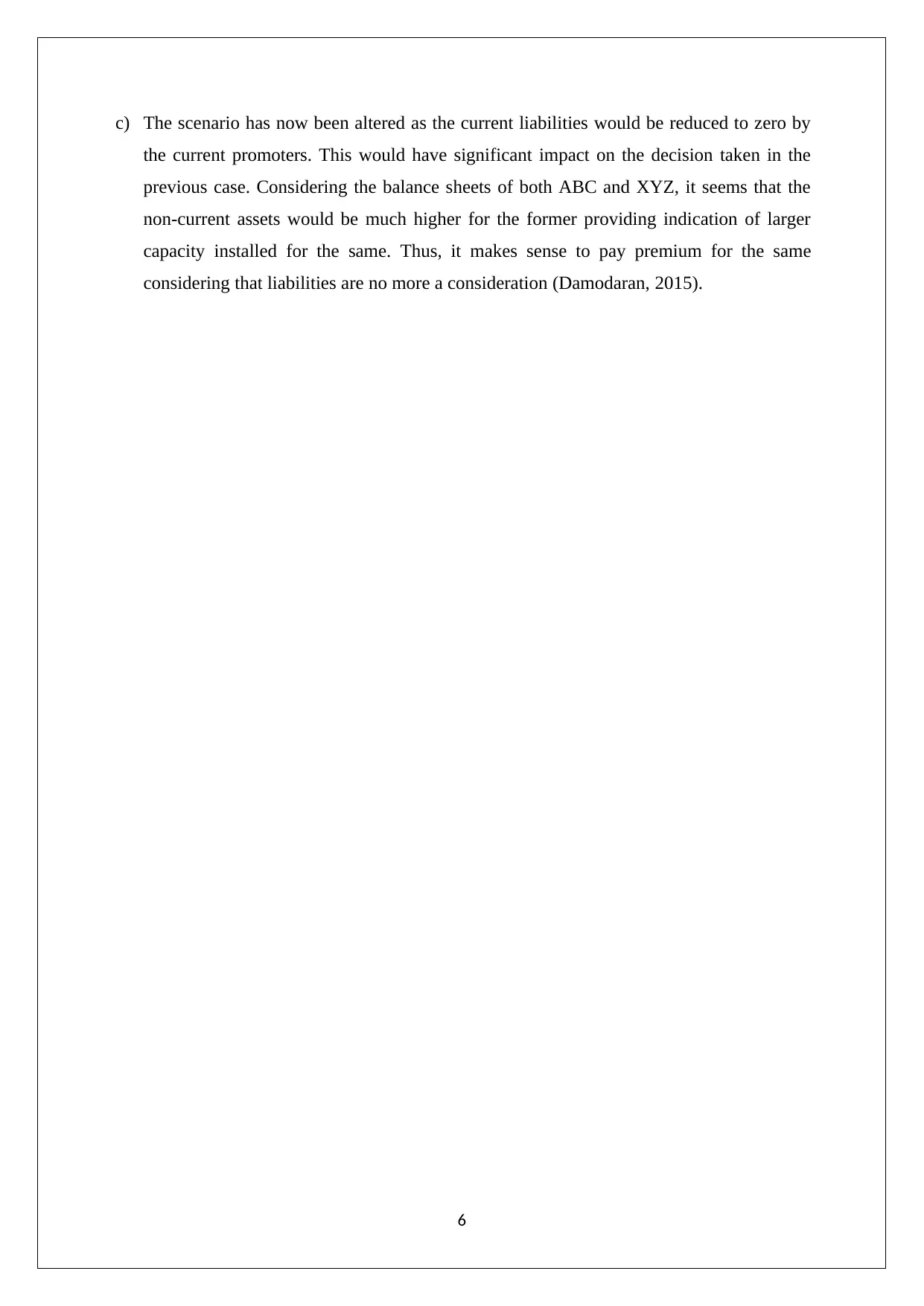
c) The scenario has now been altered as the current liabilities would be reduced to zero by
the current promoters. This would have significant impact on the decision taken in the
previous case. Considering the balance sheets of both ABC and XYZ, it seems that the
non-current assets would be much higher for the former providing indication of larger
capacity installed for the same. Thus, it makes sense to pay premium for the same
considering that liabilities are no more a consideration (Damodaran, 2015).
6
the current promoters. This would have significant impact on the decision taken in the
previous case. Considering the balance sheets of both ABC and XYZ, it seems that the
non-current assets would be much higher for the former providing indication of larger
capacity installed for the same. Thus, it makes sense to pay premium for the same
considering that liabilities are no more a consideration (Damodaran, 2015).
6
⊘ This is a preview!⊘
Do you want full access?
Subscribe today to unlock all pages.

Trusted by 1+ million students worldwide
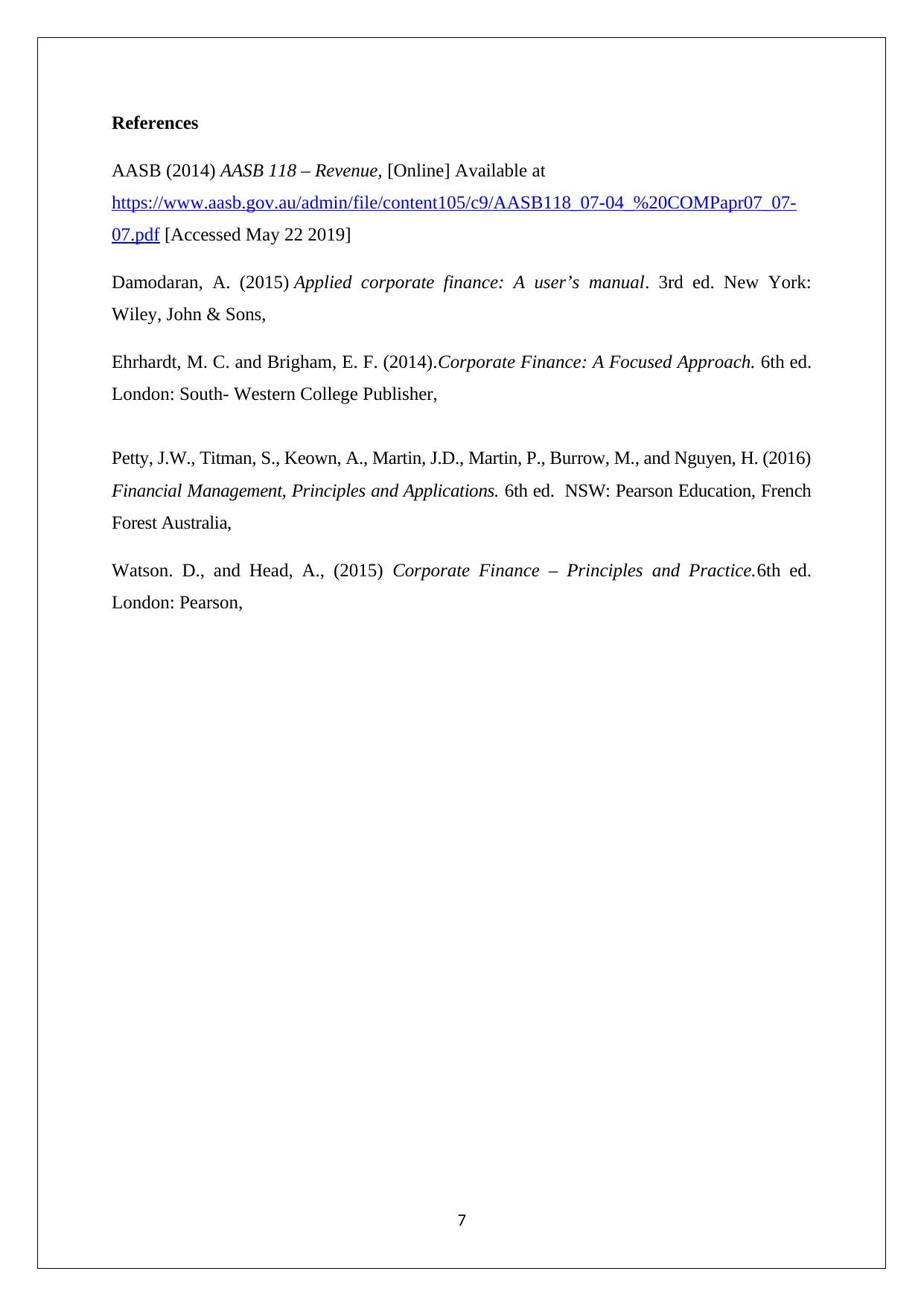
References
AASB (2014) AASB 118 – Revenue, [Online] Available at
https://www.aasb.gov.au/admin/file/content105/c9/AASB118_07-04_%20COMPapr07_07-
07.pdf [Accessed May 22 2019]
Damodaran, A. (2015) Applied corporate finance: A user’s manual. 3rd ed. New York:
Wiley, John & Sons,
Ehrhardt, M. C. and Brigham, E. F. (2014).Corporate Finance: A Focused Approach. 6th ed.
London: South- Western College Publisher,
Petty, J.W., Titman, S., Keown, A., Martin, J.D., Martin, P., Burrow, M., and Nguyen, H. (2016)
Financial Management, Principles and Applications. 6th ed. NSW: Pearson Education, French
Forest Australia,
Watson. D., and Head, A., (2015) Corporate Finance – Principles and Practice.6th ed.
London: Pearson,
7
AASB (2014) AASB 118 – Revenue, [Online] Available at
https://www.aasb.gov.au/admin/file/content105/c9/AASB118_07-04_%20COMPapr07_07-
07.pdf [Accessed May 22 2019]
Damodaran, A. (2015) Applied corporate finance: A user’s manual. 3rd ed. New York:
Wiley, John & Sons,
Ehrhardt, M. C. and Brigham, E. F. (2014).Corporate Finance: A Focused Approach. 6th ed.
London: South- Western College Publisher,
Petty, J.W., Titman, S., Keown, A., Martin, J.D., Martin, P., Burrow, M., and Nguyen, H. (2016)
Financial Management, Principles and Applications. 6th ed. NSW: Pearson Education, French
Forest Australia,
Watson. D., and Head, A., (2015) Corporate Finance – Principles and Practice.6th ed.
London: Pearson,
7
1 out of 7
Related Documents
Your All-in-One AI-Powered Toolkit for Academic Success.
+13062052269
info@desklib.com
Available 24*7 on WhatsApp / Email
![[object Object]](/_next/static/media/star-bottom.7253800d.svg)
Unlock your academic potential
Copyright © 2020–2025 A2Z Services. All Rights Reserved. Developed and managed by ZUCOL.





